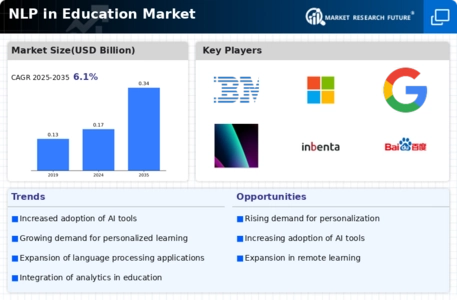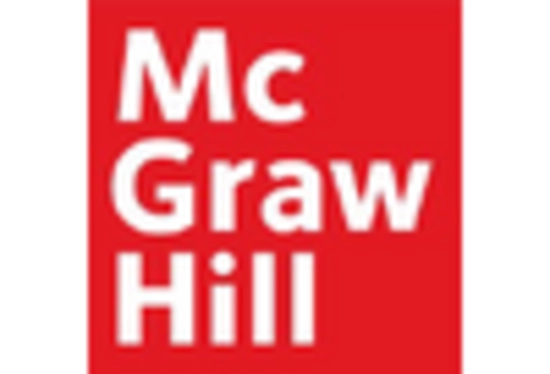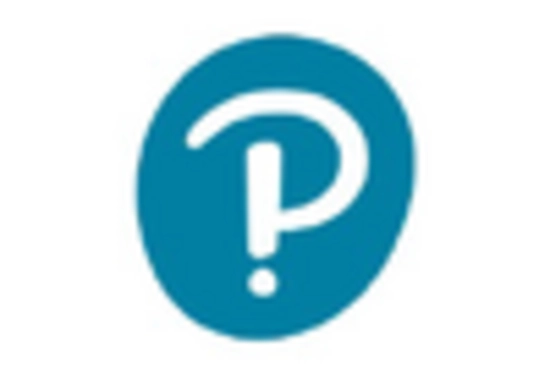-
EXECUTIVE SUMMARY
-
MARKET INTRODUCTION
-
Definition
-
Scope of the Study
- Research Objective
- Assumptions
- Limitations
-
RESEARCH METHODOLOGY
-
Overview
-
Data Mining
-
Secondary Research
-
Primary Research
- Primary Interviews
- Breakdown of Primary Respondents
-
and Information Gathering Process
-
Forecasting Model
-
Market Size Estimation
- Bottom-Up Approach
- Top-Down Approach
-
Data Triangulation
-
Validation
-
MARKET DYNAMICS
-
Overview
-
Drivers
-
Restraints
-
Opportunities
-
MARKET FACTOR ANALYSIS
-
Value Chain Analysis
-
Porter’s Five Forces Analysis
- Bargaining Power
- Threat of New Entrants
- Threat of Substitutes
- Intensity of Rivalry
-
of Suppliers
-
5.2.2.
-
Bargaining Power of Buyers
-
COVID-19 Impact Analysis
- Market Impact Analysis
- Regional Impact
- Opportunity and
-
Threat Analysis
-
6.
-
NLP IN EDUCATION MARKET, BY TYPE
-
Overview
-
Cloud Based
-
On-premises
-
NLP IN EDUCATION MARKET, BY APPLICATIONS
-
Overview
-
Business
-
Personal
-
NLP IN EDUCATION MARKET, BY REGION
-
Overview
-
North America
- U.S.
- Canada
-
Europe
- Germany
- France
- U.K
- Italy
- Spain
- Rest of Europe
-
Asia-Pacific
- China
- India
- Japan
- South Korea
- Australia
- Rest of Asia-Pacific
-
Rest of the World
- Middle East
- Africa
- Latin America
-
COMPETITIVE LANDSCAPE
-
Overview
-
Competitive Analysis
-
Market Share Analysis
-
Major Growth Strategy
-
in the NLP in Education Market,
-
Competitive Benchmarking
-
Leading Players in Terms of Number of Developments
-
in the NLP in Education Market,
-
Key developments and Growth Strategies
- New PRODUCT Launch/End-Use Deployment
- Merger & Acquisitions
- Joint Ventures
-
Major Players Financial
- Major Players R&D Expenditure. 2022
-
Matrix
-
9.8.1.
-
Sales & Operating Income, 2022
-
COMPANY PROFILES
-
IBM
- Company Overview
- Financial Overview
- Product Offered
- Key Developments
- SWOT Analysis
- Key Strategies
-
Microsoft
- Company Overview
- Financial Overview
- Product Offered
- Key Developments
- SWOT Analysis
- Key Strategies
-
Google
- Company Overview
- Financial Overview
- Product Offered
- Key Developments
- SWOT Analysis
- Key Strategies
-
AWs
- Company Overview
- Financial Overview
- Product Offered
- Key Developments
- SWOT Analysis
- Key Strategies
-
SAS Institute
- Company Overview
- Financial Overview
- Product Offered
- Key Developments
- SWOT Analysis
- Key Strategies
-
Inbenta
- Company Overview
- Financial Overview
- Product Offered
- Key Developments
- SWOT Analysis
- Key Strategies
-
Baidu
- Company Overview
- Financial Overview
- Product Offered
- Key Developments
- SWOT Analysis
- Key Strategies
-
Welocalize
- Company Overview
- Financial Overview
- Product Offered
- Key Developments
- SWOT Analysis
- Key Strategies
-
NICE
- Company Overview
- Financial Overview
- Product Offered
- Key Developments
- SWOT Analysis
- Key Strategies
-
ABBYY
- Company Overview
- Financial Overview
- Product Offered
- Key Developments
- SWOT Analysis
- Key Strategies
-
Automated Insights
- Company Overview
- Financial Overview
- Product Offered
- Key Developments
- SWOT Analysis
- Key Strategies
-
Width.ai
- Company Overview
- Financial Overview
- Product Offered
- Key Developments
- SWOT Analysis
- Key Strategies
-
Revolve.ai
- Company Overview
- Financial Overview
- Product Offered
- Key Developments
- SWOT Analysis
- Key Strategies
-
Primer.ai
- Company Overview
- Financial Overview
- Product Offered
- Key Developments
- SWOT Analysis
- Key Strategies
-
CarnegieLearning
- Company Overview
- Financial Overview
- Product Offered
- Key Developments
- SWOT Analysis
- Key Strategies
-
Gecko
- Company Overview
- Financial Overview
- Product Offered
- Key Developments
- SWOT Analysis
- Key Strategies
-
lvy.ai
- Company Overview
- Financial Overview
- Product Offered
- Key Developments
- SWOT Analysis
- Key Strategies
-
Attivio
- Company Overview
- Financial Overview
- Product Offered
- Key Developments
- SWOT Analysis
- Key Strategies
-
Conversica
- Company Overview
- Financial Overview
- Product Offered
- Key Developments
- SWOT Analysis
- Key Strategies
-
Avaamo
- Company Overview
- Financial Overview
- Product Offered
- Key Developments
- SWOT Analysis
- Key Strategies
-
Aylien
- Company Overview
- Financial Overview
- Product Offered
- Key Developments
- SWOT Analysis
- Key Strategies
-
Haptik
- Company Overview
- Financial Overview
- Product Offered
- Key Developments
- SWOT Analysis
- Key Strategies
-
Gupshup
- Company Overview
- Financial Overview
- Product Offered
- Key Developments
- SWOT Analysis
- Key Strategies
-
Sensforth.ai
- Company Overview
- Financial Overview
- Product Offered
- Key Developments
- SWOT Analysis
- Key Strategies
-
Chivox
- Company Overview
- Financial Overview
- Product Offered
- Key Developments
- SWOT Analysis
- Key Strategies
-
Cognii
- Company Overview
- Financial Overview
- Product Offered
- Key Developments
- SWOT Analysis
- Key Strategies
-
APPENDIX
-
References
-
Related Reports
-
-
LIST OF TABLES
-
NLP IN EDUCATION MARKET,
-
SYNOPSIS, 2018-2032
-
TABLE
-
NLP IN EDUCATION MARKET, ESTIMATES & FORECAST, 2018-2032 (USD BILLION)
-
NLP IN EDUCATION
-
MARKET, BY TYPE, 2018-2032 (USD BILLION)
-
NLP IN EDUCATION MARKET, BY APPLICATIONS, 2018-2032
-
(USD BILLION)
-
TABLE
-
NORTH AMERICA NLP IN EDUCATION MARKET, BY TYPE, 2018-2032 (USD BILLION)
-
NORTH AMERICA
-
NLP IN EDUCATION MARKET, BY APPLICATIONS, 2018-2032 (USD BILLION)
-
NORTH AMERICA NLP IN
-
EDUCATION MARKET, BY COUNTRY, 2018-2032 (USD BILLION)
-
U.S. NLP IN EDUCATION MARKET, BY TYPE, 2018-2032
-
(USD BILLION)
-
TABLE
-
U.S. NLP IN EDUCATION MARKET, BY APPLICATIONS, 2018-2032 (USD BILLION)
-
CANADA NLP IN
-
EDUCATION MARKET, BY TYPE, 2018-2032 (USD BILLION)
-
CANADA NLP IN EDUCATION MARKET, BY APPLICATIONS,
-
EUROPE NLP IN EDUCATION MARKET, BY TYPE, 2018-2032 (USD BILLION)
-
EUROPE NLP IN
-
EDUCATION MARKET, BY APPLICATIONS, 2018-2032 (USD BILLION)
-
EUROPE NLP IN EDUCATION MARKET, BY COUNTRY,
-
GERMANY NLP IN EDUCATION MARKET, BY TYPE, 2018-2032 (USD BILLION)
-
GERMANY NLP
-
IN EDUCATION MARKET, BY APPLICATIONS, 2018-2032 (USD BILLION)
-
FRANCE NLP IN EDUCATION
-
MARKET, BY TYPE, 2018-2032 (USD BILLION)
-
FRANCE NLP IN EDUCATION MARKET, BY APPLICATIONS,
-
ITALY NLP IN EDUCATION MARKET, BY TYPE, 2018-2032 (USD BILLION)
-
ITALY NLP IN
-
EDUCATION MARKET, BY APPLICATIONS, 2018-2032 (USD BILLION)
-
SPAIN NLP IN EDUCATION MARKET, BY TYPE,
-
SPAIN NLP IN EDUCATION MARKET, BY APPLICATIONS, 2018-2032
-
(USD BILLION)
-
TABLE
-
U.K NLP IN EDUCATION MARKET, BY TYPE, 2018-2032 (USD BILLION)
-
U.K NLP IN EDUCATION
-
MARKET, BY APPLICATIONS, 2018-2032 (USD BILLION)
-
REST OF EUROPE NLP IN EDUCATION MARKET,
-
BY TYPE, 2018-2032 (USD BILLION)
-
REST OF EUROPE NLP IN EDUCATION MARKET, BY APPLICATIONS, 2018-2032
-
(USD BILLION)
-
TABLE
-
ASIA PACIFIC NLP IN EDUCATION MARKET, BY TYPE, 2018-2032 (USD BILLION)
-
ASIA PACIFIC
-
NLP IN EDUCATION MARKET, BY APPLICATIONS, 2018-2032 (USD BILLION)
-
ASIA PACIFIC NLP IN
-
EDUCATION MARKET, BY COUNTRY, 2018-2032 (USD BILLION)
-
JAPAN NLP IN EDUCATION MARKET, BY TYPE,
-
JAPAN NLP IN EDUCATION MARKET, BY APPLICATIONS, 2018-2032
-
(USD BILLION)
-
TABLE
-
CHINA NLP IN EDUCATION MARKET, BY TYPE, 2018-2032 (USD BILLION)
-
CHINA NLP IN EDUCATION
-
MARKET, BY APPLICATIONS, 2018-2032 (USD BILLION)
-
INDIA NLP IN EDUCATION MARKET, BY TYPE,
-
INDIA NLP IN EDUCATION MARKET, BY APPLICATIONS, 2018-2032
-
(USD BILLION)
-
TABLE
-
AUSTRALIA NLP IN EDUCATION MARKET, BY TYPE, 2018-2032 (USD BILLION)
-
AUSTRALIA NLP
-
IN EDUCATION MARKET, BY APPLICATIONS, 2018-2032 (USD BILLION)
-
SOUTH KOREA NLP IN EDUCATION
-
MARKET, BY TYPE, 2018-2032 (USD BILLION)
-
SOUTH KOREA NLP IN EDUCATION MARKET, BY APPLICATIONS,
-
REST OF ASIA-PACIFIC NLP IN EDUCATION MARKET, BY TYPE, 2018-2032
-
(USD BILLION)
-
TABLE
-
REST OF ASIA-PACIFIC NLP IN EDUCATION MARKET, BY APPLICATIONS, 2018-2032 (USD
-
BILLION)
-
TABLE
-
REST OF WORLD NLP IN EDUCATION MARKET, BY TYPE, 2018-2032 (USD BILLION)
-
REST OF WORLD
-
NLP IN EDUCATION MARKET, BY APPLICATIONS, 2018-2032 (USD BILLION)
-
REST OF WORLD NLP IN
-
EDUCATION MARKET, BY COUNTRY, 2018-2032 (USD BILLION)
-
MIDDLE EAST NLP IN EDUCATION MARKET, BY
-
TYPE, 2018-2032 (USD BILLION)
-
MIDDLE EAST NLP IN EDUCATION MARKET, BY APPLICATIONS, 2018-2032
-
(USD BILLION)
-
TABLE
-
AFRICA NLP IN EDUCATION MARKET, BY TYPE, 2018-2032 (USD BILLION)
-
AFRICA NLP IN EDUCATION
-
MARKET, BY APPLICATIONS, 2018-2032 (USD BILLION)
-
LATIN AMERICA NLP IN EDUCATION MARKET, BY
-
TYPE, 2018-2032 (USD BILLION)
-
LATIN AMERICA NLP IN EDUCATION MARKET, BY APPLICATIONS, 2018-2032
-
(USD BILLION)
-
-
LIST OF FIGURES
-
RESEARCH PROCESS
-
MARKET STRUCTURE
-
FOR THE NLP IN EDUCATION MARKET
-
MARKET DYNAMICS FOR THE NLP IN EDUCATION MARKET
-
NLP IN EDUCATION
-
MARKET, SHARE (%), BY TYPE, 2022
-
NLP IN EDUCATION MARKET, SHARE (%), BY APPLICATIONS, 2022
-
NLP IN EDUCATION
-
MARKET, SHARE (%), BY REGION, 2022
-
NORTH AMERICA: NLP IN EDUCATION MARKET, SHARE (%),
-
BY REGION, 2022
-
FIGURE
-
EUROPE: NLP IN EDUCATION MARKET, SHARE (%), BY REGION, 2022
-
ASIA-PACIFIC: NLP IN
-
EDUCATION MARKET, SHARE (%), BY REGION, 2022
-
REST OF THE WORLD: NLP IN EDUCATION MARKET,
-
SHARE (%), BY REGION, 2022
-
NLP IN EDUCATION MARKET: COMPANY SHARE ANALYSIS, 2022 (%)
-
IBM: FINANCIAL
-
OVERVIEW SNAPSHOT
-
FIGURE
-
IBM: SWOT ANALYSIS
-
FIGURE
-
MICROSOFT: FINANCIAL OVERVIEW SNAPSHOT
-
MICROSOFT: SWOT ANALYSIS
-
GOOGLE: FINANCIAL OVERVIEW
-
SNAPSHOT
-
FIGURE
-
GOOGLE: SWOT ANALYSIS
-
AWS: FINANCIAL OVERVIEW SNAPSHOT
-
AWS: SWOT ANALYSIS
-
SAS INSTITUTE.: FINANCIAL OVERVIEW SNAPSHOT
-
SAS INSTITUTE.:
-
SWOT ANALYSIS
-
FIGURE
-
INBENTA: FINANCIAL OVERVIEW SNAPSHOT
-
INBENTA: SWOT ANALYSIS
-
BAIDU: FINANCIAL OVERVIEW SNAPSHOT
-
BAIDU: SWOT
-
ANALYSIS
-
FIGURE
-
WELOCALIZE: FINANCIAL OVERVIEW SNAPSHOT
-
WELOCALIZE: SWOT ANALYSIS
-
NICE: FINANCIAL OVERVIEW
-
SNAPSHOT
-
FIGURE
-
NICE: SWOT ANALYSIS
-
FIGURE
-
ABBYY: FINANCIAL OVERVIEW SNAPSHOT
-
ABBYY: SWOT ANALYSIS
-
AUTOMATED INSIGHTS: FINANCIAL OVERVIEW
-
SNAPSHOT
-
FIGURE
-
AUTOMATED INSIGHTS: SWOT ANALYSIS
-
WIDTH.AI: FINANCIAL OVERVIEW SNAPSHOT
-
WIDTH.AI: SWOT
-
ANALYSIS
-
FIGURE
-
REVOLVE.AI: FINANCIAL OVERVIEW SNAPSHOT
-
REVOLVE.AI: SWOT ANALYSIS
-
PRIMER.AI: FINANCIAL
-
OVERVIEW SNAPSHOT
-
FIGURE
-
PRIMER.AI: SWOT ANALYSIS
-
CARNEGIELEARNING: FINANCIAL OVERVIEW SNAPSHOT
-
CARNEGIELEARNING: SWOT
-
ANALYSIS
-
FIGURE
-
GECKO: FINANCIAL OVERVIEW SNAPSHOT
-
GECKO: SWOT ANALYSIS
-
LVY.AI: FINANCIAL OVERVIEW SNAPSHOT
-
LVY.AI: SWOT
-
ANALYSIS
-
FIGURE
-
ATTIVIO: FINANCIAL OVERVIEW SNAPSHOT
-
ATTIVIO: SWOT ANALYSIS
-
CONVERSICA: FINANCIAL OVERVIEW SNAPSHOT
-
CONVERSICA:
-
SWOT ANALYSIS
-
FIGURE
-
AVAAMO: FINANCIAL OVERVIEW SNAPSHOT
-
AVAAMO: SWOT ANALYSIS
-
AYLIEN: FINANCIAL OVERVIEW SNAPSHOT
-
AYLIEN: SWOT
-
ANALYSIS
-
FIGURE
-
HAPTIK: FINANCIAL OVERVIEW SNAPSHOT
-
HAPTIK: SWOT ANALYSIS
-
GUPSHUP: FINANCIAL OVERVIEW SNAPSHOT
-
GUPSHUP: SWOT
-
ANALYSIS
-
FIGURE
-
SENSFORTH.AI: FINANCIAL OVERVIEW SNAPSHOT
-
SENSFORTH.AI: SWOT ANALYSIS
-
CHIVOX: FINANCIAL
-
OVERVIEW SNAPSHOT
-
FIGURE
-
CHIVOX: SWOT ANALYSIS
-
COGNII: FINANCIAL OVERVIEW SNAPSHOT
-
COGNII: SWOT ANALYSIS









Leave a Comment